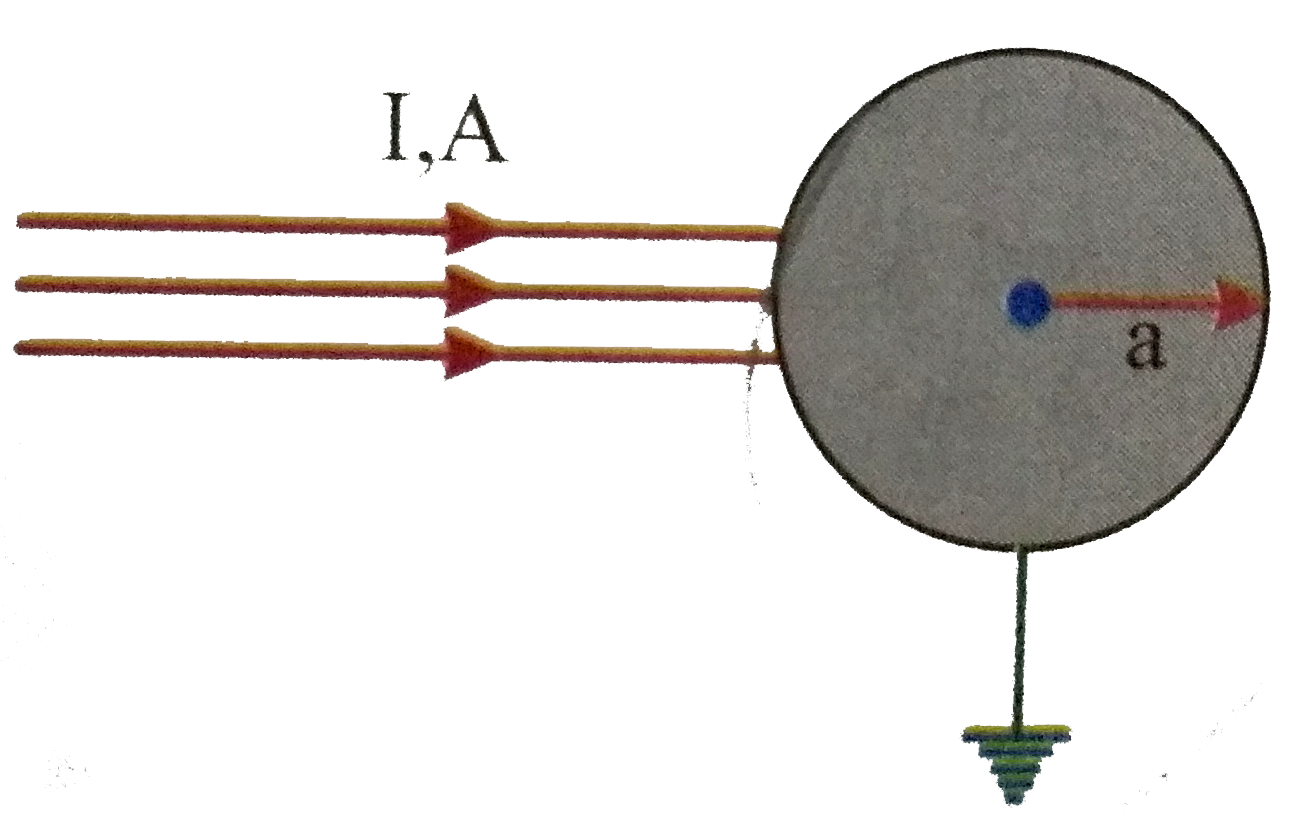A beam of ligth having frequency v is incident on an initially neutral metal or work function ϕ(hv>ϕ). Then
all emitted photoelectrons have kinetic energy equal to (hv>ϕ)
all free electrons in the metal, that absorb photons of energy hv completely, may not be ejected out of the metal.
after being emitted out of the metal, the kinetic energy of photoelectrons decreases continuously as long as they are at a finite distance from metal .
the emitted photo electrons move with constant speed after escaping from the electric field of metal.
The correct Answer is:B, C
Some electrons in the interior of the metal may use all the energy absorbed by them in coming on to the surface hence those can't come out.After being emitted electrons get retarted due to positive potential devolped on the metal (due to loss of electrons)
Topper's Solved these Questions
- BOOK - NARAYNACHAPTER - DUAL NATUREEXERCISE - LEVEL-I(H.W)7videos
DUAL NATURE
- BOOK - NARAYNACHAPTER - DUAL NATUREEXERCISE - LEVEL-I (H.W)7videos
DUAL NATURE
- BOOK - NARAYNACHAPTER - DUAL NATUREEXERCISE - LEVEL-V31videos
DUAL NATURE
- BOOK - NARAYNACHAPTER - DUAL NATURE OF RADIATION AND MATTEREXERCISE - ASSERTION AND REASON15videos
DUAL NATURE OF RADIATION AND MATTER
- BOOK - NARAYNACHAPTER - ELECTRIC CHARGES AND FIELDSEXERCISE - EXERCISE -443videos
ELECTRIC CHARGES AND FIELDS
Similar Questions
A light beam of frequency v incident on a metal of work function ϕ ,which is kept in ,region of uniform magnetic field →B .What will be greatest radius of circle traced by photo electrons
View SolutionPhotoelectric effect is a phenomenon of emission of electrons from the surfaces of a metal when the light of suitable frequency falls on it. If light of frequency v falls on a photosenstive surface of work function ϕ0, then the maximum kinetic energy of photoelectron emitted is given by Einstein's photoelectric equation.
(KE)max=12mv2max=hv−ϕ0
The value (KE)max will increases if the energy of the incident light (hv) increases of work function (ϕ0) is decreased. Read above passage and answer the following questions:
(i) Why can visible light not ejected photoelectrons from every surface?
(ii) Light of frequency 7.21×1014Hz is incident on a metal surface. Electrons with a maximum speed of 6.0×105ms−1 are ejected from the surface. What is the threshold frequency for photo emission of electrons? h=6.6×10−34Js,me=9.1×10−31kg.
(iii) What do you learn basically from the above study?View Solution
Knowledge Check
- Question 1 - Select One
A parallel beam of monochromatic radiation of cross-section area A(<πa2), intensity I and frequency v is incident on a solid conducting sphere of work functionϕ0[hv>ϕ0] and radius 'a'. The sphere is grounded by a conducting wire. Assume that for each incident photon one photoelectron is ejected. Just after this radiation is incident on initially unchanged sphere, the current through the conducting wire is:
 AIaehvBIae2hvC2IaehvDnone of these
AIaehvBIae2hvC2IaehvDnone of these - Question 2 - Select One
A when a photon of energy hv is incidnet on an electron in a metal of work function ϕ(<hv) , the electron will not necesserily come out of the metal .
R : work function is the minimum energy required to liberate an electron out of a metal . So some electons may require more energy for their liberation .AIf both Assertion & Reason are ture and the reason is the correct explanation of the assertion , then mark (1) .BIf both Assertion & Reason are true but the reason is not the correct explanation of the assertion , then mark (2) .CIf Assertion is true statement but Reason is false , then mark (3)DIf both Assertion and Reason are false statements , then mark (4) . - Question 3 - Select One
A light beam of frequency v incident on a metal of work function ϕ ,which is kept in ,region of uniform magnetic field →B .What will be greatest radius of circle traced by photo electrons
Ahv−ϕBB√hv−ϕeBC(√(2m(hv−ϕ))eB)D(√(2mhv)eB)
A beam of light of wavelength λ is incident on a metal having work function ϕ and placed on a metal having work function ϕ and placed in a magnetic field B. The most energetic electrons emitted perpendicular to the field are bent in circular arcs of radius R. Then
View SolutionWhen light of frequency v1 incident on a metal with work function W0 (where hv1>W0), the photocurrent falls to zero at a stopping potential of V1. If the frequency of light is increased to v2, the stopping potential changes to V2. Therefore, the charge of an electron is given by
View SolutionThe maximum velocity of an electron emitted by light of wavelength λ incident on the surface of a metal of work function ϕ, is
Where h = Planck's constant , m = mass of electron and c = speed of light.View SolutionIn photoelectric effect light of certain frequency (> threshold frequency ) is incident on a metal surfave whereby , an e− ( with certain K.E.) moves towards the collector plate and a flow of current is initiated . In order to stop the current flow, an opposite potential , on the two metal plates, is applied
A light of frequency 2.5×1015Hz is incident on a metal surface having work function 4 eV. The velocity of photoelectron is ( in cm s−1)View SolutionWhen photons of energy hv are incident on the surface of photosensitive material of work function hv0, then
View Solution

